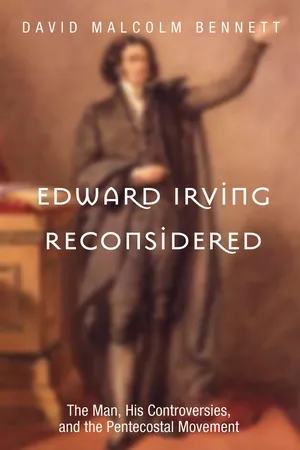![]()
1
His Family and Childhood
Edward Irving “was the freest, brotherliest, bravest human soul mine ever came in contact with. I call him, on the whole, the best man I have ever . . . found in this world, or now hope to find.
—Thomas Carlyle
Two important but highly controversial Christian figures were born in the year 1792: Charles Finney and Edward Irving. They were born into an age of revolution, and each in his own way created spiritual revolution in his respective sphere. In America Finney quite deliberately carved out a new, revolutionary, and dubious theology of evangelism and conversion, while Irving’s revolution in Scotland and London seems to have been no less deliberate, but over a wider range of issues. This book is the sad story of this Scottish revolutionary, Edward Irving—free, brotherly and brave, and in some respects, foolish, imprudent, and misunderstood.
Edward Irving was born in Annan, Scotland, on August 4, 1792. He was the fourth of nine children—three boys and six girls—born to Gavin and Mary Irving. The “sandy-blond” Gavin (pronounced “Ga-yin”) was “tallish” and “of rugged countenance, which broke out oftenest into some innocent fleer of merriment, or readiness to be merry.” Gavin Irving was a tanner by trade, though in later life was prosperous enough to be able to supervise that work “from afar,” though “afar” is probably metaphoric, for the tanning yard was just across the street from their home. He even served for a time as bailie, or magistrate, in Annan. Thomas Carlyle, the eminent writer, knew the wider Irving family and called them “cheerfully quiet, rational and honest people, of a good-natured and prudent turn.”
Mary Lowther Irving, originally from neighboring Dornoch, was “a tall, black-eyed handsome woman . . . thrifty, assiduous, wise, if somewhat fussy” and “full of affection and tender anxiety for her children and husband.” Her brother George was famous as the local giant. George was placid and even-tempered, yet when roused to anger on one occasion was said to have bent a poker around an antagonist’s neck. Edward Irving seems to have inherited his physical characteristics, including his height and strength, mainly from the Lowther side of the family, and his emotional traits, such as his even temper, from both sides.
According to The Christian Observer of September 1823, Irving is said to have claimed in an address to be descended from the Albigenses, a dualistic Middle Ages sect, while Andrew Landale Drummond and Oliphant state that he had Huguenot ancestors on the Lowther side. The latter is more likely than the former. The report about the Albigenses may have appeared because of a scribal error.
Irving’s mother’s great-grandfather was Rev. Thomas Howy, the minister at the Annan Kirk for much of the first half of the eighteenth century. Irving’s grandparents on his father’s side were also dedicated Christians. Irving claimed that they rose an hour before the rest of the family to pray for their children, even at harvest time.
Edward’s brothers John and George both reached adulthood, but died young and unmarried. John, a doctor, died in India on Edward’s birthday, a date Edward later observed as a fast day. Four of his sisters married.
The Irvings were regulars at the Kirk in Annan, though were unfortunate in that their minister had a fondness for drink that marred, even destroyed, his ministry. Partly because of this, some in his parish often walked the six miles to a Burgher seceding church in Ecclefechan, where the life and preaching of its minister, Rev. John Johnston, were not so impaired. From about the age of ten Edward Irving became part of this dissenting group, regularly hiking the distance and joining in the spiritual conversations with his older companions. Fit, strong, and healthy, the long trek was not a great difficulty for him. This venture, which seems to have continued until he went to university, was not entirely approved by his parents. It was, perhaps, made more acceptable to them in that Edward’s schoolteacher was usually in the traveling party and because one of Edward’s uncles lived in Ecclefechan and attended that church. It could have been at this church that Irving first learned his particular understanding of the humanity of Christ.
It appears to have been these experiences that stirred in Irving a love for the Scottish Covenanters, those men and women who had remained loyal to the Presbyterian faith during the persecutions in the late seventeenth century. Irving claimed “with unwearied foot” to have visited “almost every one” of the graves of those martyred at that time. As he once said, “The blood of [these] martyrs mingled with our running brooks; their hallowed bones now moulder in peace within their silent tombs.” Their heroic story greatly appealed to his developing Romantic thinking. To Irving, they were not just a part of Scottish history, they were an essential part of his ideal, romanticized Scotland.
It has proven impossible to identify a conversion experience in Irving’s life. Perhaps conversions in traditional Presbyterian circles are often perceived to be gradual rather than sudden and are thus less identifiable, or perhaps, in the course of time, it has just slipped under the radar. In fact, as shall be seen, there are...
